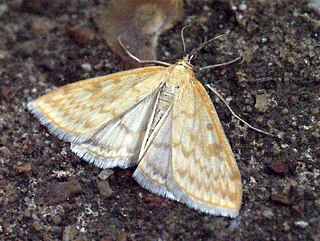
The Crambidae are the grass moth family of lepidopterans. They are variable in appearance, the nominal subfamily Crambinae taking up closely folded postures on grass stems where they are inconspicuous, while other subfamilies include brightly coloured and patterned insects which rest in wing-spread attitudes.

The Pyralidae, commonly called pyralid moths, snout moths or grass moths, are a family of Lepidoptera in the ditrysian superfamily Pyraloidea. In many classifications, the grass moths (Crambidae) are included in the Pyralidae as a subfamily, making the combined group one of the largest families in the Lepidoptera. The latest review by Eugene G. Munroe and Maria Alma Solis retain the Crambidae as a full family of Pyraloidea.

The Pyraloidea are a moth superfamily containing about 16,000 described species worldwide, and probably at least as many more remain to be described. They are generally fairly small moths, and as such, they have been traditionally associated with the paraphyletic Microlepidoptera.

Udea ferrugalis, the rusty dot pearl, is a moth of the family Crambidae. The species was first described by Jacob Hübner in 1796.

Sitochroa verticalis, common name lesser pearl, is a species of moth of the family Crambidae.

Nymphicula is a genus of moths of the family Crambidae.

Sclerocona is a genus of moths of the family Crambidae which contains only one species, Sclerocona acutella. It was first described by the Prussian biologist Eduard Friedrich Eversmann in 1842.

Parapoynx fluctuosalis or Fluctuating China-mark or Waved China-mark, is a moth of the family Crambidae. It is a widespread species, known from Africa, India, Sri Lanka, China, Japan, Malaysia, Taiwan, Guam, Hawaii, Fiji, Australia and the Galápagos Islands. It is also an introduced species in Europe, where it has been recorded from Great Britain, the Iberian Peninsula and Sardinia.

Hypsopygia mauritialis is a moth of the family Pyralidae described by Jean Baptiste Boisduval in 1833. It is a widespread species, known from Africa, India, China, Malaysia, Taiwan, Japan, Australia and Hawaii.

Pyralis regalis is a species of snout moth. It is found from most of Europe east to Asia, including China, Cambodia, Myanmar, India, Russia, Korea, Japan and Taiwan.
Assara hoeneella is a species of snout moth in the genus Assara. It was described by Roesler in 1965, and is known from China and Japan.
Stericta angusta is a species of snout moth. It is found in Japan.
Pseudacrobasis is a genus of snout moths.
Anania luctualis is a species of moth in the family Crambidae. It is found in France, Switzerland, Austria, Italy, Croatia, Bosnia and Herzegovina, Hungary, Slovakia, Romania, Poland, Belarus and Russia. In the east, the range extends to China and Japan.

Botyodes diniasalis is a species of moth in the family Crambidae. It is found on the Canary Islands, as well as in Taiwan, China, Japan and Russia. It has also been recorded from Mali, South Africa and the Himalaya.

Loxostege turbidalis is a species of moth in the family Crambidae. It was described by Treitschke in 1829. It is found in most of Europe, except Ireland, Great Britain, Norway, the Benelux and the Iberian Peninsula. It has also been recorded from Russia, Turkey, China and Japan.
Orthaga onerata is a species of snout moth in the genus Orthaga. It is found in Japan.
Parapoynx ussuriensis is a moth in the family Crambidae. It was described by Rebel in 1910. It is found in Russia and Japan.
Patissa fulvosparsa is a moth in the family Crambidae. It was described by Arthur Gardiner Butler in 1881. It is found in China, Taiwan, Japan, Korea, India and Indonesia.











